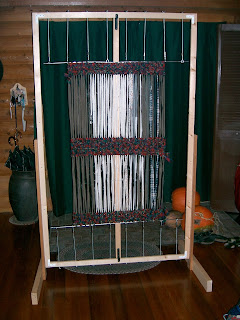 I thought this book was great not only for beginners but for more advanced rug makers as well. I use a rotary blade to cut strips if ripping isn't an option (like textured fabric, some wools, delicate silks).
I thought this book was great not only for beginners but for more advanced rug makers as well. I use a rotary blade to cut strips if ripping isn't an option (like textured fabric, some wools, delicate silks).
I used an old picture frame for my first loom. For my second longer rug, I nailed a row of finishing nails into two pieces of scrap wood and tied each piece to a heavy piece of furniture, stretching the warp the length! Finally, my husband built me a standing loom.
 |
| Standing rug loom. |
 |
| Nails in scrap wood! |
 |
| Large loom with cloth strips as warp. |
I collect used kimonos, yukatas, curtains, bedspreads, lap blankets and cloth remnants from friends, family and the rubbish bins. I launder them, cut or tear into strips and come up with a design.
 |
| Discarded kimono |
 |
| Cut or torn strips (I do this outdoors to avoid the fine dust!) |
 |
| Piles of cloth strips ready to use. |
No comments:
Post a Comment